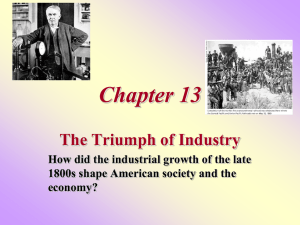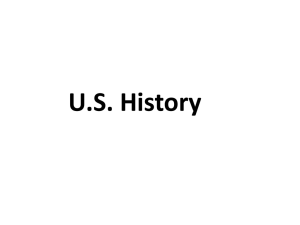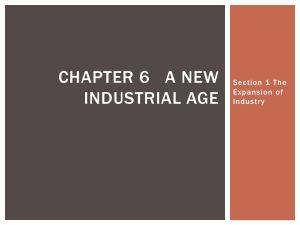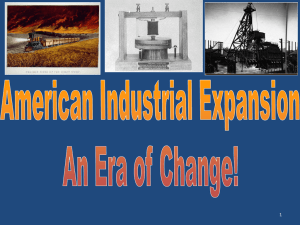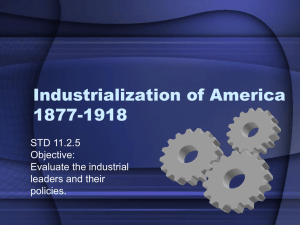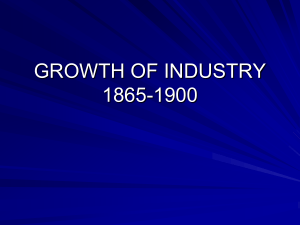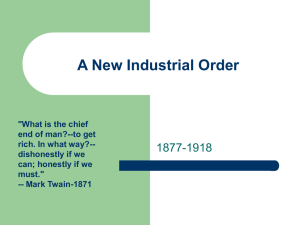File
advertisement
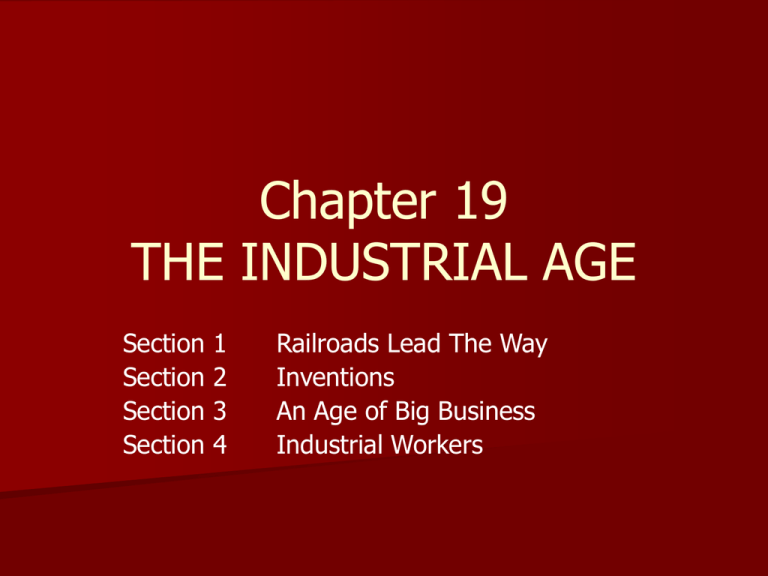
Chapter 19 THE INDUSTRIAL AGE Section Section Section Section 1 2 3 4 Railroads Lead The Way Inventions An Age of Big Business Industrial Workers Section 1 Railroad Expansion – During Civil War, trains carried troops and supplies – After war, railroad grew rapidly and drove economic growth in US ( 30,000 to 193,000 miles of track) – Railroad expansion came with consolidation, the practice of combining separate companies, in the industry – Large companies buy smaller ones and force them out of business – Makes larger companies more efficient, set standard pricing, makes processes more uniform. Sect 1 cont’d Railroad Barons – Railroad barons- powerful individuals that controlled the nation’s rail traffic - Cornelius Vanderbilt - empire stretched NY to Great Lakes - James Hill - Great Northern Line, Minnesota to Wash. - Huntington/Stanford- Central Pacific – Aggressive and competitive – Few laws that regulated business Sect 1 cont’d Railroad Stimulate the Economy – Railroads carried raw materials - Iron ore, coal, and timber to factories – Carried manufactured goods - from factories to markets - Produce from farms to area cities Sect 1 cont’d Demand for iron and locomotives helped the iron mining. 1800’s, tracks went from iron to steel Using steel, stimulated America’s steel industry Railroads effected the lumber industry, for railway ties, coal industry for fuel for the trains, and railroad companies provided work for thousands. Sect 1 cont’d Improving the Railroads - increase use made of rails, it necessary to expand and unify systems - with rails running across the country, different lines had different rails with different widths and gauges - With this, one train could not use another lines rails - With this, it created gaps in service and made travel very slow - With the companies consolidated, companies adopted “standard gauge”- 4’-8.5” as the width of the track - This allowed faster shipment of goods at a reduced cost - To more loading and unloading from one train to another Sec1 cont’d Railroad Technology - Improvements came along with the new technology - George Westinghouse air brakes Eli H. Janney couplers Gustavus Swift refrigerated cars George Pullmanluxury cars Sect 1 cont’d Competing for Customers - competed fiercely for customers, old and new - large companies offered “rebates”, or secret discounts to their biggest customers - smaller companies couldn’t match the discounts and were often forced out of business - big discounts raised freight rates for farmers and others who ship small amounts - barons also made secret agreements among themselves called (pools) - divided business among their companies and set rates - no other competition means they can charge higher rates and earn higher profits - some laws were created to regulate but did little to stop it Section 1 cont’d Essay Question # 1 How did the Railroad stimulate the economy? 1. 2. 3. 4. 5. 6. 7. 8. 9. 10. 11. 12. Created new economic links. Carried raw materials to factories. Carried manufactured goods to market. Carried products from farms to cities. Help iron industry – iron for tracks. Help steel industry – steel for tracks. Help timber industry – timber for railroad ties. Help coal industry – fuel for trains. Work for thousands of people. Laid tracks, build station houses. Manufacture railcars and equipment. Redistributed the population (labor force) Section 2 Communications – By 1910 Americans in cities drove cars through streets lit with electric lights – Department stores where they bought everything from kitchen sinks to shoes – Americans could do their shopping by mail or pick up the phone and order from a local store – The car, electric light and telephone were invented after 1870. – Within a generation, they became part of everyday life. – Improvements in communications help unify the country and promote economic growth. Section 2 cont’d The Telegraph – Invented by Samuel Morse 1844 – By 1860, US had 1,000 miles of telegraph lines managed by Western Union Telegraph company – Trained operators “transmitted”, or sent messages in morse code. – Telegrams offered instant communication – Storekeepers ordered goods – Reporters transmitted stories to newspapers – American used telegrams to send personal messages – Telegraphs linked the US to Europe (in 1860 news from Europe to US took several weeks on ships) – Cyrus Field laid a telegraph cable across Atlantic. – Transmitted messages within seconds bringing US and Europe closer. Section 2 cont’d The Telephone Rings in – Invented by Alexander Graham Bell – Born and educated in Scotland moved to US to study methods for teaching hearing impaired people to speak – Experimented with sending voices through electrical wires – 1876 developed a device that transmitted speech – telephone – Formed the Bell Telephone Company in 1877 – 1890s had sold hundreds of thousands of phones – Businesses were first customers ten before long telephones were common in homes Section 2 cont’d The Genius of Invention – Between 1860 and 1890 US government granted more than 400,000 patents – Many inventions were designed to help business operate more efficiently – Christopher Sholes – typewriter (1868) – William Burroughs – adding machine (1888) – Other inventions for everyday life – George Eastman – small box camera a.k.a. Kodak – John Thurman – vacuum cleaner Section 2 cont’d The Wizard of Menlo Park – Thomas Edison dull by his teachers, poor hearing, trouble in school and often did not attend his mother home schooled Twelve years old got a job with railroad 1st invention – a gadget to send automatic telegraph signals (so he could sleep on the job) 1876 set up a workshop in Menlo Park New Jersey from here came the phonograph, motion picture projector and others Most important invention by far is the light bulb (1879) In 1882 Edison built the 1st central electric power plant illuminating 85 buildings in New York City. Section 2 cont’d George Westinghouse – Took Edison’s work with electricity further – Developed and built transformers that could send electric power cheaper over longer distances – As a result, factories, trolleys, streetlights and lamps across the US could be powered by electricity Section 2 cont’d African American Inventors – A number of African Americans contributed to the era of inventions – Lewis Howard Latimer – improved wire for light bulbs – Granville Woods – electric incubator, electromagnetic brake (railroad), automatic circuit breaker – Elijah McCoy – mechanism for oiling machinery – Jan E. Matzeliger – shoemaking machine (performed many steps performed previously by hand) Section 2 cont’d Changing Society – Improvements ushered in a new era of transportation – Henry Ford’s automobile Wanted to build an inexpensive car to last a lifetime 1903 established his own auto making company 1906 “we are going to get a car now that we can make in great volume and get the price way down.” Then came the model T (1908) “Anyone can afford, anyone could drive anywhere, almost anyone can keep and repair” Sold 15 million Model T’s. Section 2 cont’d Ford pioneered a new cheaper way to make cars – assembly line – Each worker performed an assigned job again and again – The assembly line enabled manufacturers to produce large quantities more quickly – “Mass production” of goods decreased manufacturing cost, so products sold cheaper Section 2 cont’d Selling Goods - Merchants looked for efficient ways to sell goods - One method was mail - Some created “mail order” business - Montgomery Wards - Sears Roebuck - Chain Stores-stores with same stores in many places grew quickly - “five and ten” stores specialized in everyday household and personal items at bargain prices Sect 2 cont’d Essay Question #2 Name 5 inventors and describe the inventions they are known for. 1. 2. 3. 4. 5. 6. 7. 8. George Westinghouse – Air brakes for Trains. Gustavus Swift – Refrigerated Train Cars. Cyrus Field – Transatlantic Telegraph line. Alexander G. Bell – Telephone. George Eastman – Camera John Thurman – Vacuum Cleaner Jan E. Matzeliger – Shoemaking machine. Henry Ford – Assembly line. Section 3 Foundations for Growth – Black sticky substance – petroleum – seeped from the ground – 1850 – could burn petroleum to make heat, also to lubricate machinery – Oil becomes valuable – Edwin Drake – thought he could find oil by digging a well – 1st well – Titusville, PA struck oil – Created multi-million dollar industry Section 3 cont’d Factors of Production – New technology transportation and business methods – tap into rich supply of natural resources – Change from agricultural economy to an industrial one was possible because the US had what it needed; land, labor and capital Land – – not just land itself but all natural resources Labor – – Large number of workers to turn raw materials into goods – Needed due to population growth (pop. Doubled between 1860 and 1900) Capital – (money for investments) – Manufactured goods used to make other goods and services – Machines, buildings and tools are examples of capital goods. – One source to make capital is the sale of stock Section 3 cont’d Raising Capital – With an economy growing, businesses were looking to expand – To do so, they needed capital to buy materials – One way was to become a corporation (a company that sells shares or stock of its business to the public) – People who invest in the corporation are stockholders Good times – receive dividends Bad times – lose investments – Late 1800’s many bought and sold stocks in special markets – stock exchange – Growth of corporations fueled expansions – Banks made money by lending money Section 3 cont’d Oil Business – As oil grew prospectors and investors came – “oil rush” towns – John D. Rockefeller – famous figure in oil industry Four partners agree to run business together Built oil refinery (to process oil) in Cleveland, OH 1870’s formed Standard Oil company Set out to dominate oil industry (horizontal integration – combining competing companies into one Standard oil grew powerful and wealthy Section 3 cont’d Standard Oil Trust – Rockefeller lower prices to drive out competitions – Pressed customers not to deal with Rivals – Railroad to give him special rates Section3 cont’d 1882, Formed a trust (Group of companies managed by same board) – Did this by buying stock in different companies – Shareholders traded stock for standard oil stock – paid higher dividends – Equals – Standard oil is part owner of other companies – Created a monopoly – total control of an industry by a single producer. Section 3 cont’d Steel business/Steel industry growth – – – – – – – 1800’s became huge Idea material for railroad tracks and bridges Henry Bessemer – open hearth process New process produce at good prices and large amounts 1870 built steel mill plants near source of iron ore (Western PA) Pittsburgh becomes steel capital Located near Cleveland, Detroit and Chicago Section 3 cont’d Andrew Carnegie – – – – – Leading figure in American Steel 1865 invested in growing iron industry After learning Bessemer’s process, started mill near Pittsburgh 1890 dominated steel industry Became powerful by vertical integration (getting companies that provide equipment and services needed i.e. mines, warehouses, ships and railroads) – 1900’s produced half of nations steel Section 3 cont’d Philanthropist – Philanthropy – the use of money to benefit the community – Carnegie and Rockefeller Used money to fund colleges and libraries Carnegie Hall and Rockefeller Center Section 3 cont’d Corporations grow larger – – – – General trend in business was monopolies Buy stock instead of buying company outright Mergers – combining of companies Some admired, others argued that lack of competition hurts consumers – 1890 the Sherman Anti-trust act – did not allow trusts or monopolies Sect 3 cont’d Essay Question #3 How did Rockefeller create a monopoly with Standard Oil Company? 1. 2. 3. 4. 5. 6. 7. 8. 9. 10. Increase control of industry. Formed a trust (companies managed by same Board of Directors) Bought stock from different companies. Shareholders trade their stock. Purchased Standard Oil stock. Standard Oil stock paid higher dividends. Gave ownership of other companies to trust. Right to manage other companies. Created a monopoly. Rockefeller now controlled oil industry. Section 4 Working Conditions – Industrial growth means jobs – Mass production increased, people decreased – 10 to 12 hour days, 6 days a week could be fired at any time – Lost jobs to immigrants for lower pay – Conditions were bad and unsafe Steel workers – burns Coal miners – cave ins, gases, coal dust Garment workers – crowded and dangerous factories in urban areas called sweat shops Section 4 cont’d Women and Children – 1900’s one million women in workforce – No laws for pay, women paid half of men – Hundreds of kids worked – There were child labor laws but no one obeyed Section 4 cont’d Growth of labor union – – – – – – – – – – Unhappy workers organize union Unions promise better pay and conditions Skilled workers formed for specialized jobs 1800’s conditions worsened labor leaders looked to expand unions 1869 garment cutters in Philadelphia founded Noble and Holy Order of the Knights of Labor If employees found out about union would be fired Group created secret handshakes Knights of Labor grew, allowed Women, African Americans, Immigrants and Unskilled Laborers 1886 members grew to 700,000 Strikes turned public opinion against unions and they lost power Section 4 cont’d Growth of labor union cont’d – 1881 a national trade union for formed American Federation of Labor (AFL) – AFL led by Samuel Gompers (tough minded president from cigar makers union) – Fought for higher pay, shorter hours, better conditions and right to collective bargaining Collective bargaining – when unions represent workers and talk with management – Even with strikes – AFL grew to 1.6 million by 1908 Section 4 cont’d Women and the Unions – Many didn’t admit women, so they founded their own – Mary Harris Jones (Mother Jones) fought 50 years for worker’s rights – 1911 Triangle Shirtwaist company – sweatshop in New York – Fire broke out, workers couldn’t get out (mostly immigrant women) – 150 died – This pushed the ILGWU (International Ladies Garment Workers Union) to push for safer working environment Section 4 cont’d The Unions Act – 1870 – 1890 Economic depressions forced wages to drop and fire employees – This triggered strikes and sometimes violence – When depression hit – to cut cost companies forced pay cuts – People went on strike and violence and damage occurred – Companies hired “strikebreakers” and Federal troops to maintain order Section 4 cont’d Haymarket Square – 1886 - Chicago – McCormick Harvester Company gathered to protest the four dead who were killed the previous day – When police came to break up crowd, someone threw a bomb and killed a police officer – After this, public associated the labor movement with terrorism and disorder Section 4 cont’d Homestead, PA – 1892 – To weaken steelworkers union, company lowered wages – Union called strike, managers hired nonunion workers and brought in 300 armed guards – Battle left 10 dead – Governor sent in state militia to restore order – After this, steelworker union member numbers dwindled Section 4 cont’d Pullman Strike – 1894 – Union went on strike due to lowering of wages – Pullman closed plants – Railroad union supported strikers, refused to handle Pullman cars – This stopped all rail traffic – Pullman fought back with US Attorney General Richard Olney – Obtained an “injunction”, a court order, to stop union from obstructing the railways – Union Leader Eugene V. Debs refused to end strike and went to jail – President Cleveland sent Federal troops to end strike – This dealt another blow to unions – Still unions organize for better pay and working conditions Section 4 cont’d Sect 4 cont’d 1. 2. 3. 4. 5. 6. 7. 8. 9. 10. Essay Question #4 What were the working conditions of workers in the late 1800’s and early 1900’s? Noisy. Unhealthy. Steelworkers – suffered burns. Coal miners – cave-ins Gases. Coal dust. Garment Workers – damaged lungs. (Airborne dust) Crowded factories (sweatshops) Poor lighting Buildings that were firetraps.


